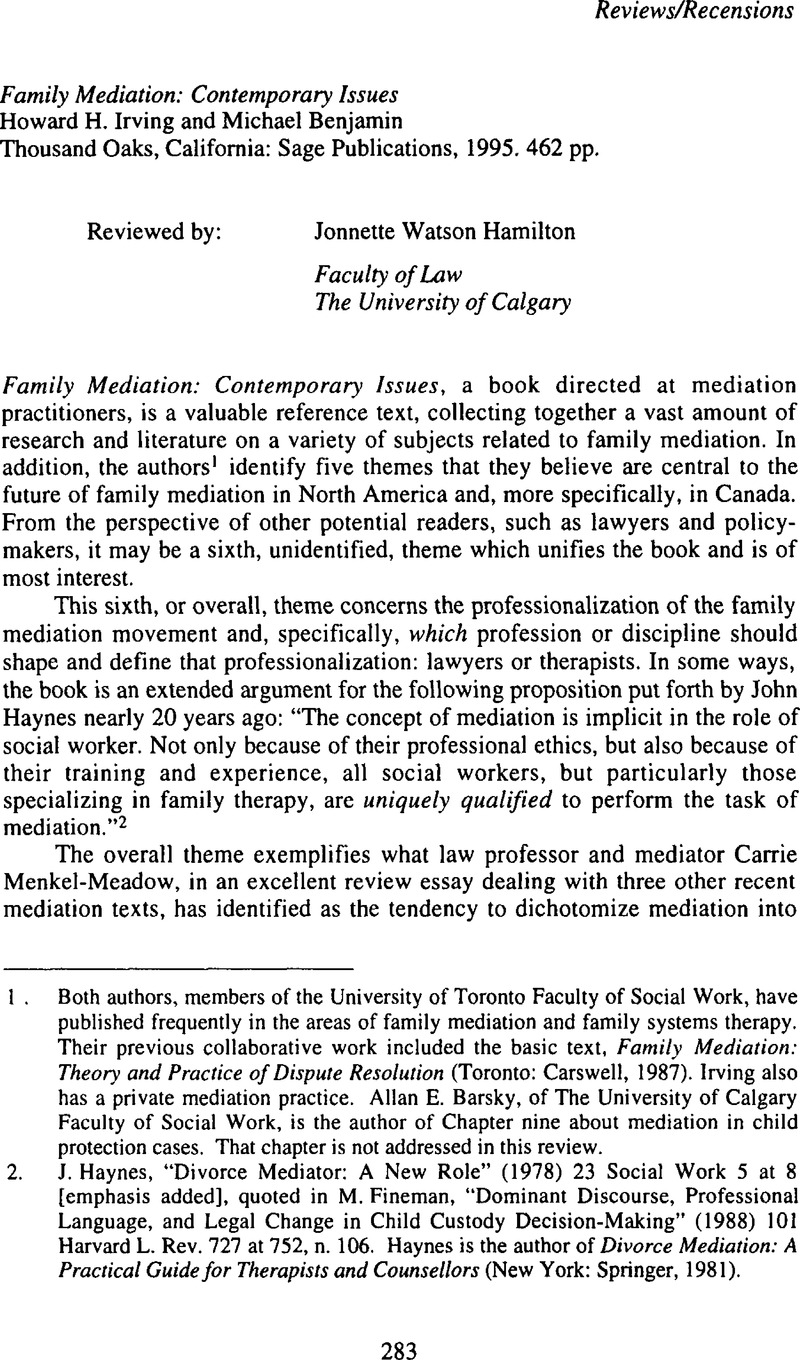No CrossRef data available.
Published online by Cambridge University Press: 18 July 2014

1. Both authors, members of the University of Toronto Faculty of Social Work, have published frequently in the areas of family mediation and family systems therapy. Their previous collaborative work included the basic text, Family Mediation: Theory and Practice of Dispute Resolution (Toronto: Carswell, 1987)Google Scholar. Irving also has a private mediation practice. Allan E. Barsky, of The University of Calgary Faculty of Social Work, is the author of Chapter nine about mediation in child protection cases. That chapter is not addressed in this review.
2. Haynes, J., “Divorce Mediator: A New Role” (1978) 23 Social Work 5 at 8Google Scholar [emphasis added], quoted in Fineman, M., “Dominant Discourse, Professional Language, and Legal Change in Child Custody Decision-Making” (1988) 101 Harvard L. Rev. 727 at 752CrossRefGoogle Scholar, n. 106. Haynes is the author of Divorce Mediation: A Practical Guide for Therapists and Counsellors (New York: Springer, 1981)Google Scholar.
3. Menkel-Meadow, C., “The Many Ways of Mediation: The Transformations of Traditions, Ideologies, Paradigms, and Practices” (1995) 11 Neg. J. 217 at 232Google Scholar. Menkel-Meadow, ibid. at 241 note 2, observes that most efforts at categorization of their initial cuts to the polarized role and task conceptions of bargaining versus therapeutic models initially described in Silbey, S. & Engle, S. M., “Mediator Settlement Strategies” (1986) 8 L. & Policy 7CrossRefGoogle Scholar.
4. Fineman, supra note 2.
5. Fineman, ibid. at 744.
6. Ibid. at 728.
7. Ibid. at 729.
8. Ibid. at 729, 769–70.
9. They come closest when they recognize that one of feminists' key objections to mediation is that it “privatizes rights and obligations whose recognition is best accomplished in the public domain” (p. 206), but this is summarized as “mediation a lesser forum.”
10. Fineman, supra note 2 at 730.
11. The authors note (p. 265) that they have moved away from a rebuttable presumption of shared parenting because their review of the studies indicates that whether shared parenting is the best option is still open to debate.
12. Fineman, supra note 2 at 741.
13. Menkel-Meadow, supra note 3 at 222. See also Kolb, D. M. et al. , When Talk Works: Profiles of Mediators (San Francisco: Jossey-Bass, 1994)Google Scholar; Greatbatch, D. & Dingwall, R., “Selective Facilitation: Some Preliminary Observations on a Strategy Used by Divorce Mediators” (1989) 23 Law & Society Rev. 613CrossRefGoogle Scholar; Dingwall, R. & Greatbatch, D., “Who is in Charge: Rhetoric and Evidence in the Study of Mediation” (1993) 6 Journal of Social Welfare & Family Law 367CrossRefGoogle Scholar.
14. Menkel-Meadow, ibid. at 238, notes a general tendency in mediation literature to sidestep issues of mediator responsibility or accountability.
15. The authors propose adopting a model of ethical decision-making from family therapy: Kitchener's model as presented by Zygmond, M. J. & Boorhem, H., “Ethical Decision Making in Family Therapy” (1989) 28 Family Process 269CrossRefGoogle ScholarPubMed. This systematic approach proposes a four-level hierarchical process dependent upon case complexity. Beginning at the intuitive level, it moves on to prescribed rules or standards (as in codes of conduct), then to ethical principles (such as autonomy, nonmaleficence, beneficence, fidelity, and justice) and, finally, if all else fails, to the motions of universalizability and doing the least avoidable harm to all involved. Such an approach, Irving and Benjamin suggest, allows a mediator to intervene to promote fairness in both procedure and outcome (p. 209).
16. While the authors' acknowledgement that family mediation in North America has been designed, for the most part, for middle-class, Anglo-Saxon couples is commendable, as is their drawing together of a variety of literature on the topic of ethnicity, their approach is somewhat problematic. The authors develop “profiles” of five ethnic groups “labelled African Americans, Caribbean Canadian blacks, Hispanics, Asians, and Jews—the latter for comparative purposes” (p. 344) and each groups' fundamental beliefs, family practices, and help-seeking behaviour. However, as the authors themselves acknowledge, each of these groups is heterogeneous and such profiles risk stereotyping the groups profiled. Indeed, in the end, the authors conclude that it is unclear how mediation practice needs to be changed to address even the information presented in the profiles.
17. See e.g. Susskind, L. E., “Environmental Mediation and the Accountability Problem” (1981) 6 Vermont L. Rev. 1Google Scholar; Pipkin, R. M. & Rifkin, J., “The Social Organization in Alternative Dispute Resolution: Implications for Professionalization of Mediation” (1984) 9 Justice System J. 204Google Scholar.
18. Flood, J. & Caiger, A., “Lawyers and Arbitration: The Juridification of Construction Disputes” (1993) 56 Modern L. Rev. 112 at 113CrossRefGoogle Scholar.
19. Twenty years ago, a classic study of Chicago lawyers found that “divorce” and “general family” areas were the two areas ranking lowest in a “Prestige Ranking of Thirty Fields of Law.” For a short summary of this research, see Heinz, J. P. & Lauman, E. O., “The Legal Profession: Client Interests, Professional Roles, and social Hierarchies” (1977–1978) 76 Michigan L. Rev. 1111CrossRefGoogle Scholar.
20. Fineman, supra note 2 at 731.
21. This appears to be true across North America and regardless of the type of dispute involved. See e.g. D. M. Kolb & K. Kressel, “The Realities of Making Talk Work” in Kolb et al., supra note 13,459 at 486.
22. Menkel-Meadow, supra note 3 at 486.
23. Kolb & Kressel, supra note 21 at 488. In their discussion of the studies in family mediation, for example, Irving and Benjamin can only conclude “that mediation is not better and no worse than litigation [depending upon the interaction of several types of variables]; in other configurations, mediation has at least the potential to be notably better” (p. 424).
24. Fineman, supra note 2 at 770.